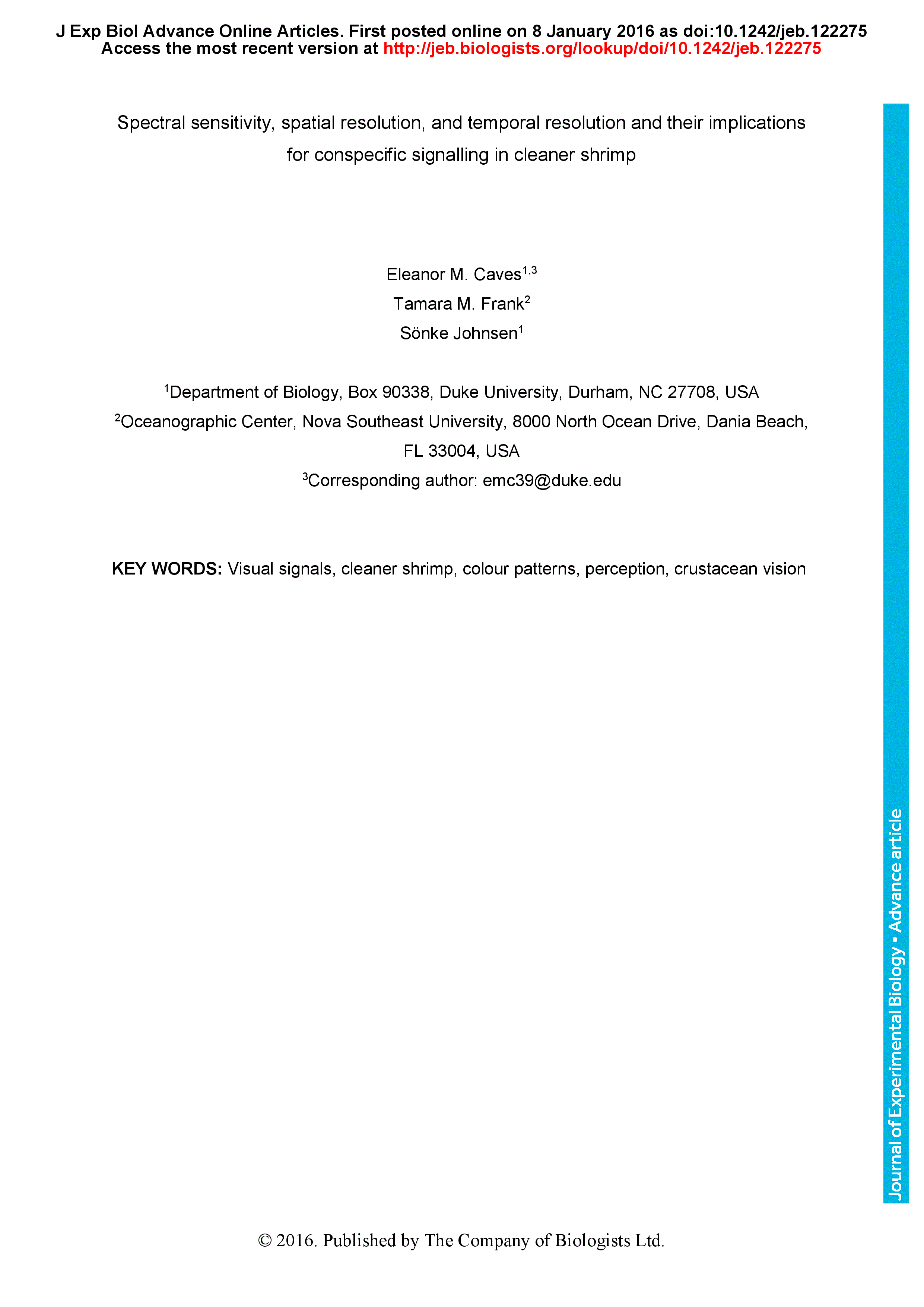Cleaner shrimp (Decapoda) regularly interact with conspecifics and client reef fish, both of which appear colourful and finely-patterned to human observers. However, whether cleaner shrimp can perceive the colour patterns of conspecifics and clients is unknown, because cleaner shrimp visual capabilities are unstudied. We quantified spectral sensitivity and temporal resolution using electroretinography (ERG), and spatial resolution using both morphological (inter-ommatidial angle) and behavioural (optomotor) methods in three cleaner shrimp species: Lysmata amboinensis, Ancylomenes pedersoni, and Urocaridella antonbruunii. In all three species, we found strong evidence for only a single spectral sensitivity peak of (mean±s.e.m.) 518±5 nm, 518±2 nm, and 533±3 nm, respectively. Temporal resolution in dark-adapted eyes was 39±1.3 Hz, 36±0.6 Hz, and 34± 1.3 Hz. Spatial resolution was 9.9±0.3°, 8.3±0.1°, and 11±0.5°, respectively, which is low compared with other compound eyes of similar size. Assuming monochromacy, we present approximations of cleaner shrimp perception of both conspecifics and clients, and show that cleaner shrimp visual capabilities are sufficient to detect the outlines of large stimuli, but not to detect the colour patterns of conspecifics or clients, even over short distances. Thus, conspecific viewers have likely not played a role in the evolution of cleaner shrimp appearance; rather, further studies should investigate whether cleaner shrimp colour patterns have evolved to be viewed by client reef fish, many of which possess tri- and tetra-chromatic colour vision and relatively high spatial acuity.
Spectral sensitivity, spatial resolution, and temporal resolution and their implications for conspecific signalling in cleaner shrimp
Currently Viewing Accepted Manuscript - Newer Version Available
- Split-screen
- Views Icon Views
- Open the PDF for in another window
-
Article Versions Icon
Versions
- Version of Record 15 February 2016
- Accepted Manuscript 01 January 2016
- Share Icon Share
-
Tools Icon
Tools
- Search Site
Eleanor M. Caves, Tamara M. Frank, Sönke Johnsen; Spectral sensitivity, spatial resolution, and temporal resolution and their implications for conspecific signalling in cleaner shrimp. J Exp Biol 2016; jeb.122275. doi: https://doi.org/10.1242/jeb.122275
Download citation file:
Advertisement
2023 JEB Outstanding Paper Prize shortlist and winner

The JEB Editors are delighted to announce the shortlisted authors for the 2023 JEB Outstanding Paper Prize. Read the winning paper - Tiny spies: mosquito antennae are sensitive sensors for eavesdropping on frog calls - by Hoover Pantoja-Sanchez and Brian Leavell from Ximena Bernal's lab at Purdue University, USA.
JEB Science Communication Workshop for ECRs

If you’re an early-career researcher interested in science communication and are attending the SEB Annual Conference in Prague this summer, come a day early and join the JEB Editors at a sci comm workshop to learn the key writing skills needed to promote your research to a broad audience beyond your peers (1 July at 14.30-17.30). Places are limited to 24 attendees, and applicants should apply through the SEB registration page by 30 April 2024.
Bridging the gap between controlled conditions and natural habitats in understanding behaviour

Novel technologies enable behavioural experiments with non-model species, in naturalistic habitats and with underexplored behaviours. In their Commentary, Scholz and colleagues discuss how to obtain a deeper understanding of the natural ecology and lifestyle of study animals.
Beluga metabolic measures could help save species

To help save animals from extinction, it’s important to understand what each species needs to survive. This led Jason John et al. to measure the metabolic rates of captive belugas to develop a ‘fish calculator’ showing that the whales need to eat ~23 salmon per day.
ECR Workshop on Positive Peer Review

Are you an ECR looking for tips on how to write concise, astute and useful manuscript reviews? If so, join the JEB Editors at a 2-hour JEB-sponsored Workshop on Positive Peer Review at the Canadian Society of Zoologists annual meeting in Moncton on 9 May 2024 at 13.00-15.00. There are 25 spaces for ECRs and selection is first come, first serve. To sign up, check the ECR Workshop box when you register for the CSZ meeting.



